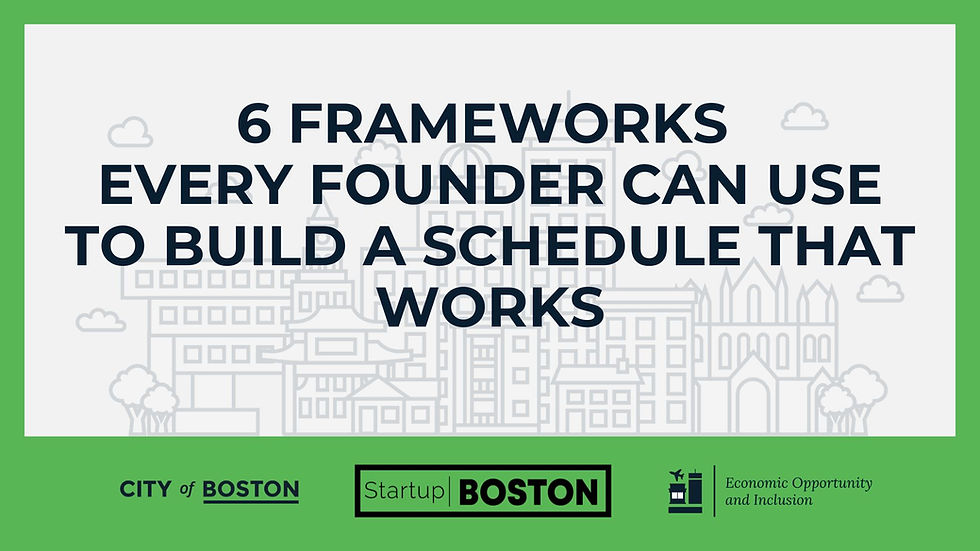Create Your MVP for Less than $100
- Jessie Ying

- Jan 11, 2021
- 4 min read
The term MVP (minimum viable product) describes a product that uses the lowest amount of effort to create the highest amount of value. Eric Ries is credited with coining the term as part of the Lean Startup methodology. In Henrik Kniberg's well known car-building example, you cannot satisfy your consumer by focusing on finding the perfect solution. The MVP approach emphasizes focusing on the needs of the consumer, and the process is adapted over time as the consumer gives feedback. It addresses the underlying pain point(s) while delivering value to users—fast, thereby allowing more iteration cycles sooner.
During the Startup Boston Week 2020 panel: Shoestring Your MVP: How to Validate Your Product for Less than $100, five Boston-based founders shared their tips and experiences on creating and running a valuable MVP test.

Build Your MVP
Test And Pivot
Building an MVP starts with understanding your users on a deeper level. You can do this through a series of user interviews.
“You want to walk away with an understanding of not just what their problems are but what their expectations are as well. You want to go beyond the demographic questions and dig deep into psychographics: what are their needs, behaviors, motivations, and fears,” said Nova Benedicto, the Director of Product Marketing at LogMeIn.
Proactively reaching out to potential consumer communities and networks is another way to expand and test your target audiences. Partnering with other complementary businesses that can deeply benefit your business and brand, and you should never skimp on competitive research, especially in an emergent market.
Control the Expense
You need to be thoughtful of bang-for-your-buck when getting an MVP scrappily out the door. One way to control cost is by leveraging video as a potent way to communicate with users. Create explainer videos to demonstrate the functionality of the product and answer any questions. It’s a straightforward way to communicate the value of the product including the who, what, where, and why in an easily digestible format that is accessible to most users.
Taking advantage of tools like freelancing platforms and online survey software is another effective and inexpensive way to get high-quality marketing content, executive assistant, and reach a broader audience without all the research operations of a larger organization. Services that can help are:
Fiverr
Upwork
Survey Monkey
“You need to be in contact with your early adopters, prospective customers, and user base on a frequent basis. I would recommend that you spend $5 out of $100 to get The Survey Playbook by Matthew Champagne,” said Gary Bartos, founder at Echobatix. As a founder or product manager, you need to identify: who can I invite to a high-impact 1:1 discussion?
Get It Out
Many companies want to address all of their user’s needs in their MVP. Instead, they should focus on the small set of user’s needs and their highest-ranked problems. Launch your product quickly, get anyone (anyone you think has the “problem” that you want to solve) to interact with your product.
Depending on your industry, your MVP could be as small as a landing webpage. “My goal is how fast can we get to market, so we can make the first dollar,” said Coach AK Ikwuakor, former pro athlete, current entrepreneur, and Google Faculty Trainer.
Run an MVP test
Gain and capture user feedback
While communicating with your users, help them understand that your company is trying to satisfy their needs and it will get better. Try to break the ice with a little humor, even try to go through informal channels. Join a Reddit or meetup group, enjoy the group before you introduce your company.
Often, the founder’s idea of what they want to build is different than what your user wants. The MVP is the initial product to the very first set of users, and the final product is going to take years to build.
MVPs should be flexible, and companies should continue to iterate and improve the solutions based on the users' insight and feedback. When they give you all different types of problems or ask for a set of features, ask them: what the problem is; why do they want to add this feature; how often do you encounter that problem; do other users also have the same problem; how intense it is; are they willing to pay for an advanced solution?
Learn through Failure
“Growing a business as an entrepreneur, you are going to fail...even with my recent interview with Tommy Hilfiger, he was talking about his failures. And all the things they had to do as a brand to pivot during COVID times,” said Taneshia Camillo-Sheffey, founder and director at MadeINcubator. Once you fail, you can identify where you did wrong, figure out how you can work through it, and how we can move on to the next goal. “The faster you can know what doesn’t work, i.e a ‘failure’, the faster you’re gonna know what is working,” said AK.
Solution Finder vs. Problem Solver
As you saw in the illustration from Henrik, you must continue improving your solution until it solves your problem. There is a big difference between building a solution and solving a problem. “Follow up with the problem, not the solution,” said Dan Gallagher, the Product Development Leader at Slalom.
When you’re building a solution, you can be focused on execution without paying attention to what’s going on around you. When you are solving a problem, you are thirsty for more feedback and input. In the end, you want to walk away with a satisfying answer to the question: does it solve the problem that I wanted to solve?
Interested in learning more? Watch the full video from SBW2020 right here on YouTube.


